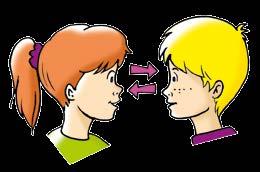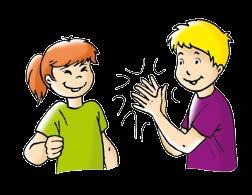
6 minute read
Tricked Out
Sometimes the effect is better if the top spins fast — and sometimes it’s better if the top spins slowly. Test it yourself!
WHAT’S HAPPENING
Advertisement
Mount a disk on the top and give it a whirl. What happens? All three disks change completely when they are in motion!
The top grows! It looks like it’s getting larger and larger. The color goes away! The different colors blend into a uniform gray. Help, it’s wobbling! The arrangement of rings suddenly looks completely regular, and some start to swing back and forth.
Bonus Experiment:
Repeat the experiment, but this time spin the top in the opposite direction. With which disk does something change? Right — with the spiral. If you spin it in the opposite direction, the top seems to shrink!
EXPERIMENT 24
Hole in your hand
YOU WILL NEED
3 1
2
4
5
WHAT’S HAPPENING
Hold the magic telescope in front of one eye and hold your other hand a little way in front of your other eye. Look into the distance and slowly guide your free hand from the end of the telescope toward your face. Try it several times if it doesn’t work right off the bat. Suddenly you’ll see a hole in your hand! Of course, in reality your hand is in good shape.
So why does it look like there’s a hole in it? You have tricked your brain! Each one of your eyes sees its own image that it conveys to the brain. Normally, these two images are pretty similar, and your brain combines the two images into a single whole — without you noticing it at all. In this experiment, though, the two images look completely different! See for yourself, by shutting each eye in turn. One eye looks through the magic telescope and sees nothing but a little circle, while the other eye sees the entire surroundings. Your brain puts the two images together as usual — and, well, the result is a lot of nonsense!
Bonus Experiment:
Even if it doesn’t look that way, the red lines are the same length, the red circles are the same size, and the wall is straight!
It’s really unbelievable what our brain can do — but it can also be deceived. Sometimes our eyes will see something that our brain analyzes in the wrong way. That’s known as an optical illusion.
EXPERIMENT 25
Staring contest
YOU WILL NEED
An assistant
Optional
1 2
If you can’t find an assistant, you can compete against the hourglass! In that case, look into the mirror during the contest.
WHAT’S HAPPENING
Look your opponent in the eye and keep your own eyes wide open: No blinking! Whoever manages to go the longest without blinking is the winner. No matter how hard you try to avoid it, sooner or later you will HAVE to blink. Your body has set things up to make that happen automatically — without your being able to prevent it. Blinking has the important function of ensuring clear vision. It keeps the eyes moist and free of tiny dust particles. This sort of automatic process serving to protect the body is known as a reflex.
DID YOU KNOW?
We have many reflexes. Breathing is one, along with coughing and sneezing. And if you accidentally touch a hot burner, your hand pulls away in an instant. Fortunately, nobody has to ponder it first: “Oh, I think that feels hot. Would it be better for me to pull my hand away? Ouch, that really hurts! Yeah, I’d better pull it away!” By that time, you would have burned yourself pretty badly. Reflexes are very sensible things for you to have, because they can save valuable time in preventing something worse from happening.
Bonus Experiment:
Position yourself in front of the other player and clap your hands once in front of her eyes. What’s her reaction? She will definitely close her eyes briefly. Blinking is also a reflex to protect the eyes when there’s a sudden loud noise. An assistant

EXPERIMENT 26
The wiggling finger
YOU WILL NEED
An assistant
1 2
At the beginning, it will be easier if the other player doesn’t just point to your finger, but taps it lightly.
3
WHAT’S HAPPENING
4
The other player points to one of your fingers. You have to try to raise that finger! It isn’t easy at all: When you cross your hands over one another, it confuses your brain: Your left and right hands are reversed, and the fingers of the two hands are switched around. To wiggle the right finger, your brain first has to mentally untangle the entire knot of fingers!
Kosmos Quality and Safety
More than one hundred years of expertise in publishing science experiment kits stand behind every product that bears the Kosmos name. Kosmos experiment kits are designed by an experienced team of specialists and tested with the utmost care during development and production. With regard to product safety, these experiment kits follow European and US safety standards, as well as our own refined proprietary safety guidelines. By working closely with our manufacturing partners and safety testing labs, we are able to control all stages of production. While the majority of our products are made in Germany, all of our products, regardless of origin, follow the same rigid quality standards.
1st Edition 2009 © 2009 Franckh-Kosmos Verlags-GmbH & Co. KG, Pfizerstrasse 5 – 7, 70184 Stuttgart, Germany. Tel. +49 (0)711 2191-343
This work, including all its parts, is copyright protected. Any use outside the specific limits of the copyright law without the consent of the publisher is prohibited and punishable by law. This applies specifically to reproductions, translations, microfilming, and storage and processing in electronic systems and networks. We do not guarantee that all material in this work is free from copyright or other protection.
Concept and text: Kerstin Kottke Project management: Kerstin Kottke, Cornelia List Product development: Petra Zimmermann Manual design: Atelier Bea Klenk, Berlin Manual layout and illustrations: komuniki - Michael Schlegel, Würzburg; Andrea Mangold, Munich Packaging design concept and layout: Peter Schmidt Group GmbH, Hamburg Packaging photos: pro-studios, Michael Flaig, Stuttgart Manual photos: Michael Flaig: p. 3; Fotolia.com: Ray, p. 11, DKStudio, p. 25, Lucky Dragon, P. 37; iStockphoto: Andres Balcazar, p. 23; Pixelio.de: Bucurescu, p. 27
The publisher has made every effort to locate the holders of image rights for all of the photos used. If in any individual cases any holders of image rights have not been acknowledged, they are asked to provide evidence to the publisher of their image rights so that they may be paid an image fee in line with the industry standard. 4th English Edition © 2011, 2013, 2015 Thames & Kosmos, LLC, Providence, RI, USA Thames & Kosmos® is a registered trademark of Thames & Kosmos, LLC. Translation: David Gamon Editing: Ted McGuire Additional Graphics and Layout: Dan Freitas
Distributed in North America by Thames & Kosmos, LLC. Providence, RI 02903 Phone: 800-587-2872; Web: www.thamesandkosmos.com
Distributed in United Kingdom by Thames & Kosmos UK, LP. Goudhurst, Kent TN17 2QZ Phone: 01580 212000; Web: www.thamesandkosmos.co.uk
We reserve the right to make technical changes.
Printed in Germany / Imprimé en Allemagne



